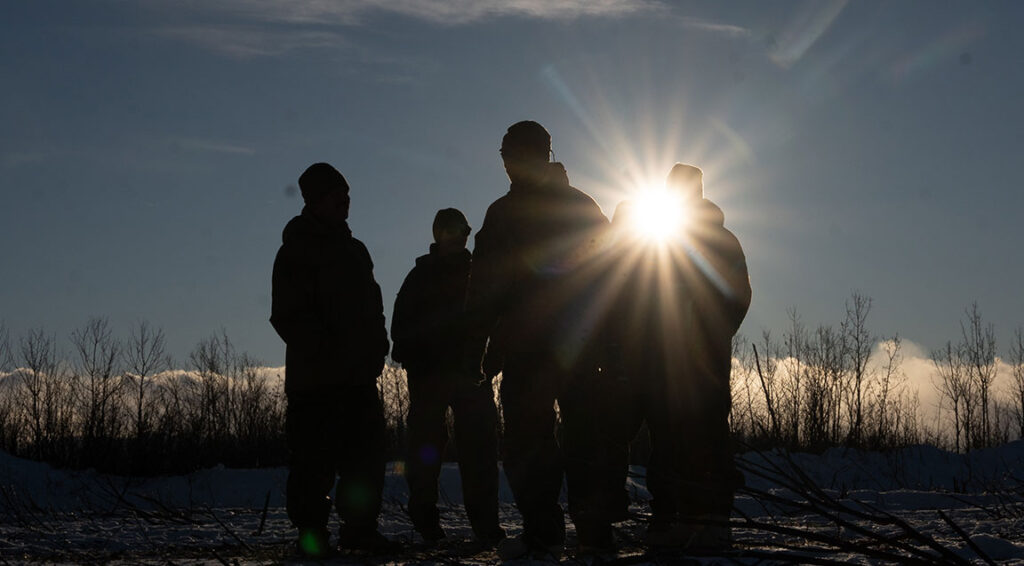U.S. Marines with Marine Air Control Squadron (MACS) 24, Marine Air Control Group 48, 4th Marine Aircraft Wing, Marine Forces Reserve, deploy an AN/TPS-80 G/ATOR (Ground/Air Task Oriented Radar) in preparation of Exercise Arctic Edge 2024 in Fort Greely, Alaska. LANCE CPL. KANOA THOMAS/U.S. MARINE CORPS
THE WATCH STAFF
The United States, alongside allies and partners, is increasing cold weather capabilities and fostering interoperability through numerous collaborative multi-domain exercises in the Arctic regions of North America and Europe. From February 23 to March 11, 2024, U.S. Northern Command (USNORTHCOM) conducted Arctic Edge 2024, a comprehensive joint and combined multidomain cold weather field training exercise spanning across numerous locations across Alaska. This exercise brought together forces from Special Operations Command North and Marine Forces North, alongside state, tribal, and local law enforcement, and stakeholders. Arctic Edge showcases the capabilities of USNORTHCOM and its component commands across various domains in the Arctic. The objective of the exercise involved cultivating and strengthening partnerships with allies and partners and evaluating the readiness of the U.S. military’s capabilities in extreme cold weather.
Simultaneously, the 11th Airborne Division wrapped up its expansive Joint Pacific Multinational Readiness Center 24-02 exercise, operating in freezing temperatures throughout Alaska with nearly 10,000 troops. While a significant portion of the participating personnel were from the U.S., other participants included personnel from Canada, Mongolia, South Korea, Sweden, and Finland. Additionally, eighteen nations observed the exercise, marking the largest iteration of the Joint Pacific Multinational Readiness Center in Alaska. This two-week endeavor not only sharpened readiness but also significantly enhanced interoperability among participating forces through realistic Arctic Circle training scenarios. This exercise highlights the importance of alliances and partnerships in addressing complex security challenges in Arctic environments.
Additionally, in mid-March, the 11th Airborne Division engaged in a joint training exercise with Norwegian forces as part of the Arctic Shock 2024. This joint effort aimed to strengthen multi-combatant command relationships, enhance airborne interoperability, and bolster Arctic capabilities. The exercise is held annually in Bardufoss, Norway. This year’s exercise involved approximately 150 U.S. Soldiers from the 11th Airborne Division and around 100 soldiers from the Norwegian Armed Forces. The exercise included flying from Alaska to Norway over the North Pole, parachuting over a frozen lake, and field training focused on cold-weather capabilities.
Maj. Gen. Brian Eifler, commanding general of the 11th Airborne Division, discussed the renewed focus on Arctic capabilities in an interview with the Norwegian newspaper, High North News. He highlighted the importance of collaboration with Arctic allies to enhance capability and interoperability, as outlined in the 2021 Arctic Strategy. Eifler emphasized the significance of regional military exercises in the Arctic for fostering partnerships and advancing interoperability. Additionally, Eifler underscored the necessity for ongoing collaboration among Arctic nations to deter potential threats, emphasizing the role of collective efforts stating, “The more we work together and demonstrate our capability, the more deterrence we can present.”
Echoing Maj. Gen. Eifel, Troy Bouffard, director for the Center for Arctic Security and Resilience at the University of Alaska Fairbanks, shed light on the significance of joint exercises and collaborations, such as Arctic Edge and the Joint Pacific Multinational Readiness Center in Alaska, in an interview with National Public Radio (NPR) which took place in February 2024. Bouffard emphasized that while there may not be a specific threat in the Arctic at present, preparedness is critical. He reflected on Russia’s military advancements in the Arctic, highlighting the need for enhanced capabilities in the region to address unforeseen future conflicts.
These joint exercises with allies and partners serve as a testament to the mission of U.S. Northern Command (USNORTHCOM) to defend the homeland and engage in security cooperation with allies and partners. In his 2024 Posture Statement, General Gregory M. Guillot, commander of USNORTHCOM, acknowledges that “the success of homeland and continental defense requires capability and capacity to conduct sustained multi-domain operations in the Arctic.”
General Guillot further emphasizes that “Success in competition, crisis, or conflict continues to rely on a ready, modern, and capable joint force reinforcing the other core elements of our national power. Our diplomatic corps is essential to shaping the strategic environment and cultivating the network of alliances and partnerships that provide the most significant U.S. advantage against isolated and authoritarian competitors.”
Joint exercises underscore the United States’ steadfast commitment to enhancing Arctic capabilities, fostering interoperability, and cultivating vital partnerships with allies and partners, while also bolstering readiness to address evolving security challenges in the Arctic region.

